
Senenmut was an 18th Dynasty ancient Egyptian architect and government official. His name translates literally as "mother's brother."

Tomb KV47, located in the Valley of the Kings in Egypt, was used for the burial of Pharaoh Siptah of the Nineteenth Dynasty. It was discovered on December 18, 1905 by Edward R. Ayrton, excavating on behalf of Theodore M. Davis; Siptah's mummy had been found earlier, cached in KV35. It was the last of the Nineteenth and Twentieth Dynasty kings tombs to be uncovered in the Valley. Ayrton stopped his excavation in 1907 due to safety fears, and Harry Burton returned in 1912 to dig further. The cutting of a side passage was halted after the workmen cut into Side Chamber Ja of the tomb of Tia'a (KV32). The tomb was unfinished at the time of its use.

Theban Tomb 69 is located in Sheikh Abd el-Qurna, part of the Theban Necropolis, on the west bank of the Nile, opposite Luxor. It is the burial place of the ancient Egyptian official named Menna, whose titles included ‘Overseer of Fields of Amun’, and ‘Overseer of Fields of the Lord of the Two Lands’. Traditionally, TT 69 has been dated to the reign of Thutmosis IV. However, recent art historical studies of artistic style suggest the majority of the tomb was decorated during the reign of Amenhotep III.
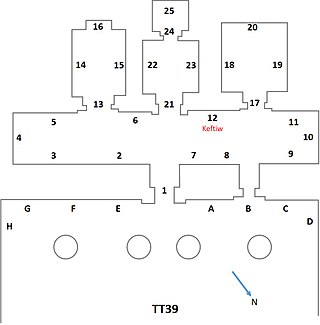
The Theban Tomb TT39 is located in El-Khokha, part of the Theban Necropolis, on the west bank of the Nile, opposite to Luxor. It is the burial place of the ancient Egyptian official, Puimre.

The Theban Tomb TT81 is located in Sheikh Abd el-Qurna, part of the Theban Necropolis, on the west bank of the Nile, opposite to Luxor. It is the burial place of the ancient Egyptian official, Ineni and his family.
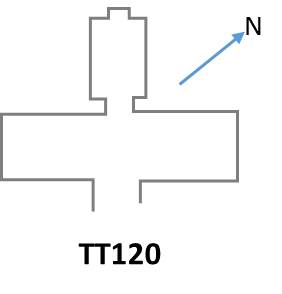
The Theban Tomb TT120 is located in Sheikh Abd el-Qurna. It forms part of the Theban Necropolis, situated on the west bank of the Nile opposite Luxor. The tomb is the burial place of the ancient Egyptian official Anen, who was the brother of Queen Tiye, and became Chancellor of Lower Egypt, Second Prophet of Amun, sem-priest of Heliopolis, and Divine Father under the reign of Amenhotep III.

The Theban Tomb TT57 is located in Sheikh Abd el-Qurna. It forms part of the Theban Necropolis, situated on the west bank of the Nile opposite Luxor. The tomb is the burial place of the ancient Egyptian official Khaemhat, who was royal scribe and overseer of double granary, during the reign Amenhotep III. The relief decoration of the tomb is regarded as the best of New Kingdom art.

Menhet, Menwi and Merti, also spelled Manhata, Manuwai and Maruta, were three minor foreign-born wives of Pharaoh Thutmose III of the Eighteenth Dynasty. They are known for their lavishly furnished rock-cut tomb in Wady Gabbanat el-Qurud near Luxor, Egypt. They are suggested to be Syrian, as the names all fit into Canaanite name forms, although their ultimate origin is unknown. A West Semitic origin is likely, but both West Semitic and Hurrian derivations have been suggested for Menwi. Each of the wives bear the title of "king's wife", and were likely only minor members of the royal harem. It is not known if the women were related as the faces on the lids of their canopic jars are all different.
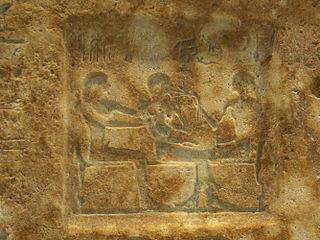
Ramose was the father and Hatnofer the mother of Senenmut, one of the most important state officials under the reign of the Egyptian queen Hatshepsut in the Eighteenth Dynasty of Egypt. The commoner origins of Ramose and the rise of his son Senenmut were long considered to be prime examples of high social mobility in New Kingdom Egypt. For instance, almost nothing is known of Ramose's origins, but he seems to have been a man of modest means—anything from a tenant peasant or farmer, to an artisan or even a small landowner. When Ramose died he was a man aged 50–60. Hatnofer was an elderly lady, with grey or even white hair. They are believed to have been born at Armant, a town only ten miles (16 km) south of Thebes within Upper Egypt presumably during the reign of Ahmose I, the founder of Egypt's illustrious 18th dynasty.

The Theban Tomb TT319 is located in Deir el-Bahari, part of the Theban Necropolis, on the west bank of the Nile, opposite to Luxor. The tomb belongs to the king's wife Neferu II, wife of the ancient Egyptian king Mentuhotep II. Neferu was the daughter of Queen Iah and Intef III.
The Theban Tomb TT47 is located in El-Khokha, part of the Theban Necropolis, on the west bank of the Nile, opposite to Luxor.

The Theban Tomb TT214 is located in Deir el-Medina, part of the Theban Necropolis, on the west bank of the Nile, opposite to Luxor.

Astronomical ceiling decoration in its earliest form can be traced to the Tomb of Senenmut (Theban tomb no. 353), located at the site of Deir el-Bahri, discovered in Thebes, Upper Egypt. The tomb and the ceiling decorations date back to the XVIII Dynasty of ancient Egypt. It is closed to the public.

The Theban Tomb TT176 is located in El-Khokha, part of the Theban Necropolis, on the west bank of the Nile, opposite to Luxor.
Theban Tomb TT382 is located in Qurnet Murai, part of the Theban Necropolis, on the west bank of the Nile, opposite to Luxor. It is the burial place of the ancient Egyptian High Priest of Montu named Usermontu, who lived during the 19th Dynasty and served under Ramesses II.
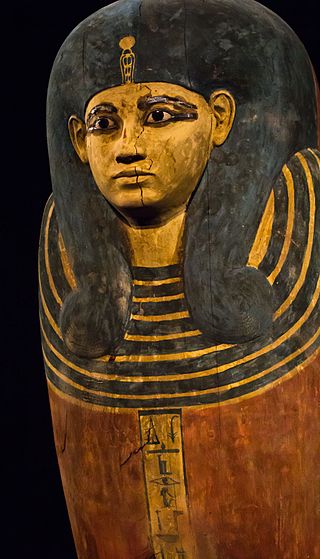
The Theban Tomb TT358 is located in Deir el-Bahari, part of the Theban Necropolis, on the west bank of the Nile, opposite to Luxor. The tomb belongs to the king's wife Ahmose-Meritamun, the sister and the wife of Pharaoh Amenhotep I. The tomb was later used for the additional burial of the King's daughter Nany, who was a daughter of Pharaoh Pinedjem I.
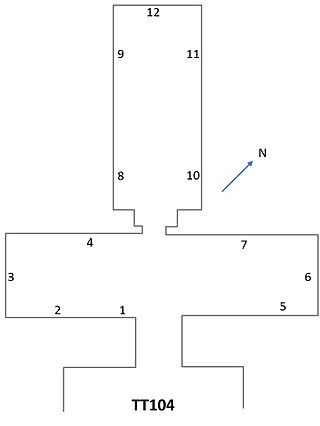
The ancient Egyptian Theban Tomb no. 104 (TT104) belongs to the Overseer of the treasuries Djehutynefer, who was in office under king Amenhotep II. The tomb chapel is located in Sheikh Abd el-Qurna and is part of the Theban Necropolis, on the west bank of the Nile, opposite to Luxor. Djehutynefer had a second tomb in Thebes TT80. Tomb TT104 is decorated with paintings and has a T shaped ground plan. The paintings are not always well preserved.
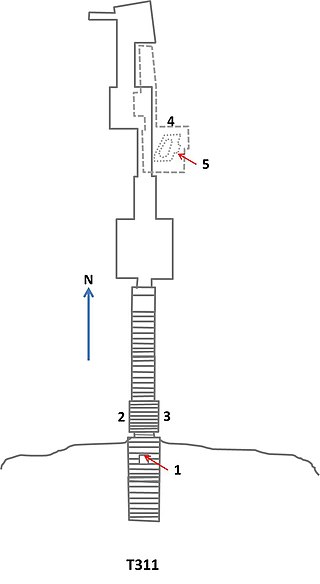
The Theban Tomb TT311 is located in Deir el-Bahari, part of the Theban Necropolis, on the west bank of the Nile, opposite to Luxor. The tomb belongs to the Seal-bearer of the King of Lower Egypt named Kheti. The tomb was excavated by Winlock during the 1923 excavations on behalf of the Metropolitan Museum of Art. Kheti had a tomb near the funerary temple of king Mentuhotep II. The tomb was found heavily destroyed but there are still many remains of reliefs showing that it was once decorated. The burial chamber was better preserved and was also decorated.

The Theban Tomb TT120 is located in Sheikh Abd el-Qurna. It forms part of the Theban Necropolis, situated on the west bank of the Nile opposite Luxor. The tomb is the burial place of the ancient Egyptian official Ahmose, who was the second prophet of Amun-Ra at Karnak and later the first prophet of Amun at Henqet-Ankh, the mortuary temple of Tuthmosis III at Qurnah during the reign of the Tuthmosis III.
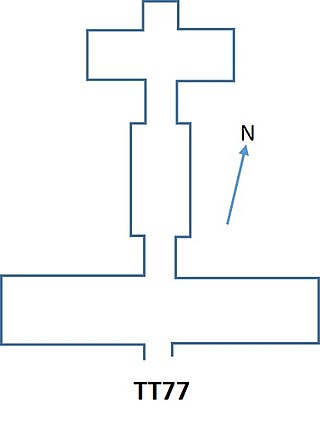
Theban Tomb 77 is located in Sheikh Abd el-Qurna, part of the Theban Necropolis, on the west bank of the Nile, opposite Luxor. It is the burial place of the Ancient Egyptian official named Ptahemhat, who was a child of the nursery, overseer of the works in the temple of Amun, and standard-bearer of the Lord of the Two Lands. The tomb dates to the reign of Tuthmosis IV.






















